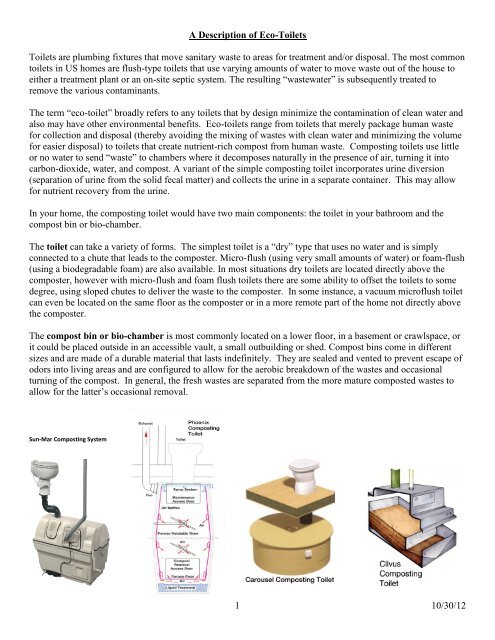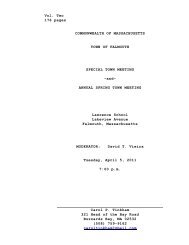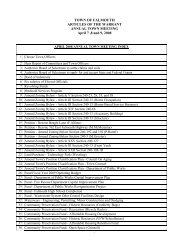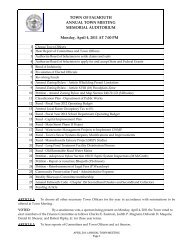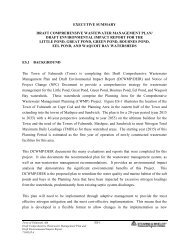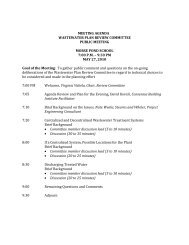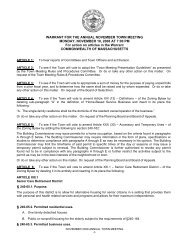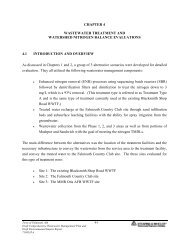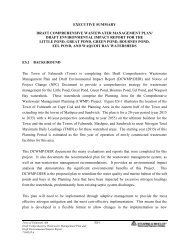Overview of Eco-Toilet Technology
Overview of Eco-Toilet Technology
Overview of Eco-Toilet Technology
Create successful ePaper yourself
Turn your PDF publications into a flip-book with our unique Google optimized e-Paper software.
A Description <strong>of</strong> <strong>Eco</strong>-<strong>Toilet</strong>s<br />
<strong>Toilet</strong>s are plumbing fixtures that move sanitary waste to areas for treatment and/or disposal. The most common<br />
toilets in US homes are flush-type toilets that use varying amounts <strong>of</strong> water to move waste out <strong>of</strong> the house to<br />
either a treatment plant or an on-site septic system. The resulting “wastewater” is subsequently treated to<br />
remove the various contaminants.<br />
The term “eco-toilet” broadly refers to any toilets that by design minimize the contamination <strong>of</strong> clean water and<br />
also may have other environmental benefits. <strong>Eco</strong>-toilets range from toilets that merely package human waste<br />
for collection and disposal (thereby avoiding the mixing <strong>of</strong> wastes with clean water and minimizing the volume<br />
for easier disposal) to toilets that create nutrient-rich compost from human waste. Composting toilets use little<br />
or no water to send “waste” to chambers where it decomposes naturally in the presence <strong>of</strong> air, turning it into<br />
carbon-dioxide, water, and compost. A variant <strong>of</strong> the simple composting toilet incorporates urine diversion<br />
(separation <strong>of</strong> urine from the solid fecal matter) and collects the urine in a separate container. This may allow<br />
for nutrient recovery from the urine.<br />
In your home, the composting toilet would have two main components: the toilet in your bathroom and the<br />
compost bin or bio-chamber.<br />
The toilet can take a variety <strong>of</strong> forms. The simplest toilet is a “dry” type that uses no water and is simply<br />
connected to a chute that leads to the composter. Micro-flush (using very small amounts <strong>of</strong> water) or foam-flush<br />
(using a biodegradable foam) are also available. In most situations dry toilets are located directly above the<br />
composter, however with micro-flush and foam flush toilets there are some ability to <strong>of</strong>fset the toilets to some<br />
degree, using sloped chutes to deliver the waste to the composter. In some instance, a vacuum micr<strong>of</strong>lush toilet<br />
can even be located on the same floor as the composter or in a more remote part <strong>of</strong> the home not directly above<br />
the composter.<br />
The compost bin or bio-chamber is most commonly located on a lower floor, in a basement or crawlspace, or<br />
it could be placed outside in an accessible vault, a small outbuilding or shed. Compost bins come in different<br />
sizes and are made <strong>of</strong> a durable material that lasts indefinitely. They are sealed and vented to prevent escape <strong>of</strong><br />
odors into living areas and are configured to allow for the aerobic breakdown <strong>of</strong> the wastes and occasional<br />
turning <strong>of</strong> the compost. In general, the fresh wastes are separated from the more mature composted wastes to<br />
allow for the latter’s occasional removal.<br />
Sun-Mar Composting System<br />
1 10/30/12
Envirolet Composting System<br />
Separett<br />
You can see a variety <strong>of</strong> systems on display, and speak with people who own eco-toilets at:<br />
The Green Center at Alchemy Farm, contact: Hilde Maingay/Earle Barnhart 508-563-3101<br />
The following companies have composting toilet products that are approved as “alternative systems” by the<br />
Massachusetts Plumbing Board:<br />
Clivus Multrum (price quotes available through website at: http://clivusne.com/costs-residentialbathrooms.php<br />
Contact person: Lisa Truchon, 978.794.9400)<br />
Advanced Composting Systems/Phoenix (price quotes available through: Ben Goldberg, 413-586-3699<br />
ben@compostingtoilet.com; www.compostingtoilet.com)<br />
<strong>Eco</strong>-tech/Carousel (price quotes available through: David DelPorto (978)-338-4000, www.ecologicalengineering.com/carousel.html<br />
or http://ecotechproducts.net/)<br />
Sun-Mar (expected to be sold through Eastman’s Hardware, 150 Main St. Falmouth, Ma. 508-548-0407<br />
http://www.sun-mar.com/index.html)<br />
Sancor Industries/Envirolet (http://www.envirolet.com/)<br />
There are also two urine-diverting (UD) toilet options available, which will require state-level plumbing<br />
product approval variances:<br />
Dubletten (contact Stubby Warmbold at: 908.735.8871 http://www.dubbletten.nu/wc-dubblettenen.html)<br />
Worstman/<strong>Eco</strong>Flush (contact Carol Steinfeld- <strong>Eco</strong>vita at: 978.318.7033 www.ecovita.net)<br />
2 10/30/12
The Separett is a UD/self-contained system that will also require a state-level product approval variance.<br />
Separett (http://www.separett-usa.com/) Distributors include Ben Goldberg 413-586-3699, Carol<br />
Steinfeld 978.318.7033, and others listed on the Separett website)<br />
Other possibilites:<br />
Pacto packaging toilet: (www.pactotoilet.com contact Jack Doyle (215)-489-1618)<br />
Aquatron gravity-based separator for your household waste stream (contact Stubby Warmbold at: 908.735.8871<br />
www.aquatron.se)<br />
Residuals. Each kind <strong>of</strong> <strong>Eco</strong>-<strong>Toilet</strong> processes wastes into "residuals" which must be managed and ultimately<br />
either disposed <strong>of</strong>f or recycled as fertilizer.<br />
A Urine-diverting toilet directs the urine to temporary storage containers in the house, which are periodically<br />
collected by a licensed septage hauler and taken to a sewer plant or to a facility where it is made pathogen-free<br />
and used directly as a fertilizer or as part <strong>of</strong> further compost production.<br />
A Composting toilet combines human wastes with added wood shavings or leaves to produce compost. The<br />
biological decomposition reduces the 'waste' material by up to 90%; much <strong>of</strong> it converts to gases including<br />
water vapor, carbon dioxide, ammonia, etc. The amount <strong>of</strong> compost produced equals about a bushel per person<br />
per year, and must be removed from the composter periodically. MA law requires that the compost be either<br />
removed by a septage hauler, or buried under 6 inches <strong>of</strong> compacted earth. If the compost toilet does not<br />
evaporate all the liquid that enters it, the excess liquid,"leachate", is stored in a container and is periodically<br />
removed by a septage hauler.<br />
An Aquatron toilet produces compost, and also uses flushing water that is treated as wastewater and that can be<br />
combined with the household greywater.<br />
A Packaging toilet directs human waste into a sealed biodegradable plastic package, which is periodically<br />
removed and composted, or disposed to a sewer plant.<br />
An <strong>Eco</strong>Drum, a modular commercial composter, can be used for further composting <strong>of</strong> residuals with additional<br />
materials (wood chips, leaves, waste food, etc.) that heats the composted material to inactivate pathogens and<br />
destroy pharmaceuticals.<br />
Greywater. Even if all <strong>of</strong> the toilets in the house are water-conserving <strong>Eco</strong>-<strong>Toilet</strong>s, other wastewater is created<br />
from bathing, washing clothes and dishes, and various uses <strong>of</strong> fixtures in the house. This wastewater, <strong>of</strong>ten<br />
called “greywater” can be disposed <strong>of</strong> in a standard septic system. So, if you replace your toilets with<br />
composting toilets, then your existing septic system may be able to receive the greywater if it is otherwise not<br />
failed. Check with the Health Department for details if you have any questions. If your existing septic-tank<br />
leachfield is failed, it will need to be replaced with a new one. The good news is, when using a composting<br />
toilet, the leachfield only has to be 60% the size <strong>of</strong> a standard leachfield, which saves money in both materials<br />
and excavation.<br />
3 10/30/12


